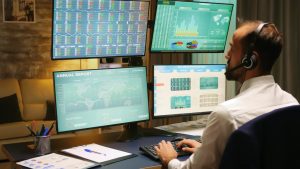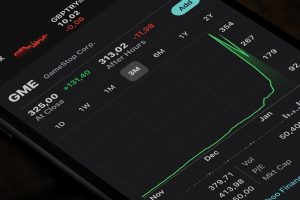A Year in Review: Top Blogs in 2021
December 8, 2021 | By: Ivy Schmerken

The retail trading boom and meme-stock trading frenzy dominated news headlines this year, along with hybrid work, supply chain disruptions, and cloud computing. In 2021, FlexAdvantage and FlexTrade Insights blogs wrote about how the pandemic accelerated various technology trends in financial markets.
We covered topics such as retail order routing in the debate over payment for order flow (PFOF); the resurgence in alternative trading systems (ATSs); the rise of outsourced trading desks; and the regulation of fixed-income trading platforms as registered venues.
Which topics attracted the most attention from readers?
The demand for desktop interoperability on the trading desk, the GameStop/meme-stock trading episode’s connection to off-exchange trading, and the data tsunami driving automation of the fixed-income trading desk, were among the most popular blogs.
On the technology front, some of the hot topics were alternative data sets in the COVID era, migration to cloud-based applications and market data services, and the evolution of algo wheels in foreign exchange.
Given this background, here is a list of the “most read” FlexAdvantage and FlexTrade Insights blogs for 2021.
- Desktop Interoperability on the Trading Desk
- GameStop Saga Puts Focus on Inaccessible Liquidity
- Fixed Income Trading Desk of the Future
- Regulating Fixed-Income Platforms: Separating Fact from Fiction
- Alternative Data’s Rising Star in Covid Era
- Algo Wheel Takes FX Algo Trading to the Next Level
- SEC Revives PFOF Debate
- ATS Innovators Speed Up Matching Engines to Discover Algo-Liquidity
- Converting Capital Markets to Cloud
- Facing Economic Headwinds, the Buy Side Turns to Outsourcing
1.Desktop Interoperability on the Trading Desk

Whether traders are working remotely from home or in a hybrid model, the demand for desktop interoperability has accelerated during the pandemic.
“In normal times, the buy-side trader navigates eight to ten screens with different applications and data feeds opened in different windows. But since the pandemic, most traders working from home have two-to-four screens at best, resulting in limited screen space,” observed Andy Mahoney, Managing Director EMEA at FlexTrade.
Momentum is building for FDC3, a set of standards contributed by desktop interop pioneer OpenFin and adopted by fintech innovators Cosaic and Glue 42. But the desktop interop movement is in different stages of evolution.
2.GameStop Saga Puts Focus on Inaccessible Liquidity

A House Financial Services Committee hearing held in February on the GameStop/meme-stock trading episode, where the CEOs of Robinhood and Citadel Securities testified, turned the focus on off-exchange trading of retail orders being routed to market-maker platforms in return for payment for order flow (PFOF).
Currently, about 50% of U.S. equity volume is traded on the major exchanges and approximately 45% is traded off-exchange. “The challenge is approximately 20%-plus of equity volume is not normally accessible,” said David Cannizzo, Managing Director, Head of Electronic Trading at Raymond James. Experts say this is affecting the calculations made by VWAP and POV algorithms, which rely on accessing all stock market volumes.
3. Fixed Income Trading Desk of the Future
An exponential increase in data is shaping the fixed-income desk of the future. Not only are fixed-income trading desks contending with streaming data from inbound liquidity providers, new issues, and pricing services.
New trading protocols are also entering the market including electronic request-for-quote or eRFQs and demand for all-to-all trading.
“But this must also be seen in the context of a buy-side firm’s view of best execution, and how the individual trader, desk, or firm defines best ex, which is interlinked to how they feel about automation, efficiency and best price,” said Paul Clarke, Senior Vice President Strategy for FlexTrade Fixed Income (FlexFI) on the firm’s webcast.
4. Regulating Fixed-Income Platforms: Separating Fact from Fiction

With the proliferation of electronic trading protocols and pricing services in fixed-income markets, execution management systems (EMSs) have expanded their functionality in fixed income to provide more efficiency and price transparency to the buy side.
Regulators at ESMA and the SEC have been seeking public comment on the regulatory framework for fixed-income trading platforms that are not registered as organized trading facilities (OTFs) under MIFID/MiFIR or alternative trading systems (ATS) under Reg ATS.
“We believe that software vendors that provide functionality for displaying prices and routing orders to fixed-income trading platforms do not meet the definition of an exchange and should not be required to register as an ATS,” stated Kedia in the comment letter.
5. Alternative Data’s Rising Star in Covid Era

Behavioral shifts and lockdowns during the pandemic have caused asset managers to seek out new signals and sources from alternative data providers.
At the Crux Informatics Summit: Fall 2020, one research expert cited interest in trade flow data related to ships moving around, specific commodities contained in a ship, and linking that to a ticker symbol.
The rise of data marketplaces has removed some of the onerous work around collecting and normalizing data feeds across multiple suppliers. “The future of alternative data is likely to move onto marketplaces,” said Adam Salem, Head of Technology and Portfolio Implementation for Multi-Asset Solutions at AllianceBernstein.
6. Algo Wheel Takes FX Algo Trading to the Next Level

Regulations such as MIFID II have shifted more responsibility on the buy side to obtain best-execution in foreign exchange trading, which has resulted in an increased uptake in algorithmic trading.
However, with so many algo choices, selecting the best-performing broker algo can be complicated. Also, the buy side will need a way to compare algos with other styles of execution such as streaming liquidity and request-for-quote (RFQ).
“The next stage of automated trading is the evolution of the algo wheel through a complement of data- driven feedback loops and machine learning to make recommendations on how to execute a particular trade,” said Uday Chebrolu, Senior Vice President and Head of Product for FlexFX at FlexTrade.
7. SEC Revives PFOF Debate

In the wake of the retail trading boom and the meme-stock trading frenzy, the Securities and Exchange Commission is conducting an analysis of retail order routing, concentration of wholesale market-makers, and payment for order flow (PFOF).
But industry experts contend that banning the controversial practice is complicated.
Citing data from 605 reports, Larry Tabb, Head of Research at Bloomberg Market Intelligence, said that PFOF benefits retail investors in terms of execution quality. “If you are an individual investor, you are getting a quarter to a third of the spread back in terms of price improvement,” said Tabb, who added, “It turns out to be a fair amount of money.”
8. ATS Innovators Speed Up Matching Engines to Discover Algo-Liquidity

There’s been a renaissance in alternative trading systems (ATSs) with new entrants designing innovative methods of matching orders in US stocks to solve liquidity problems for institutions.
One new entrant is PureStream Technologies, a U.S. stock trading venue that algorithmically matches orders against streaming block liquidity. In addition, Intelligent Cross became the first ATS to use artificial intelligence to match orders in both dark and lit order books, ranking No. 5 in the FINRA ATS rankings.
This comes amid a burst of dealmaking activity as exchanges and brokers acquired incumbent ATSs, Liquidnet and BIDS Trading, while Level ATS merged with Luminex, to fight for the 50% of market share that is traded off-exchange.
9. Converting Capital Markets to Cloud

Despite past hesitancy with latency and security around the public cloud, adoption of cloud-based market data and risk analytics has taken off since the pandemic.
Buy-and-sell-side firms that had access to cloud-based applications, networks, data, and connectivity, were able to shift to remote work and disaster recover sties with little or no disruption.
“We’re seeing cloud as a key element for reducing cost, increasing agility, and increasing the level of responsiveness across organizations,” said David Easthope, Senior Advisor, Market Structure & Technology at Greenwich Associates on a Jan. 13 webinar.
10. Facing Economic Headwinds, the Buy Side Turns to Outsourcing

Weighing the cost and complexity of running an internal trading desk, many buy-side firms have shifted to an outsourced trading desk. Among the benefits are economies of scale since the capability is set up as an internal execution desk to service multiple buy sides.
As sell-side firms set up their outsourced trading desks, they are focusing on automation, throughput, and open architecture to handle the order flow routed by multiple buy-side clients. “From a process perspective, they want to add new clients in a seamless manner, without being taxed and to achieve straight through processing (STP) to the extent possible,” said Rajiv Kedia, Principal and Associate Founder and Global Head of Sell-Side Trading Solutions at FlexTrade. “The more it’s automated, the easier it is to process, and the more cost effective it becomes,” said Kedia.
